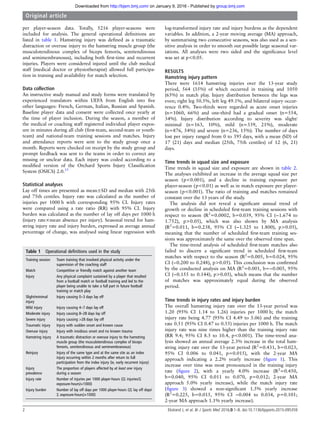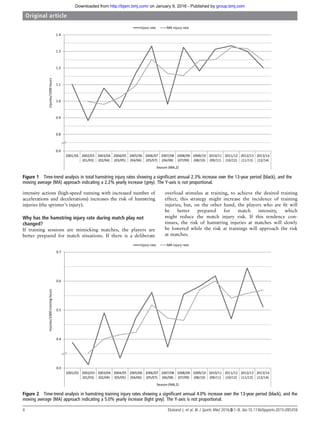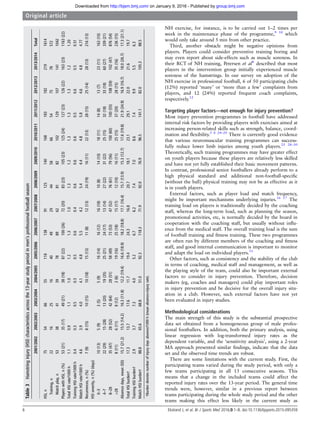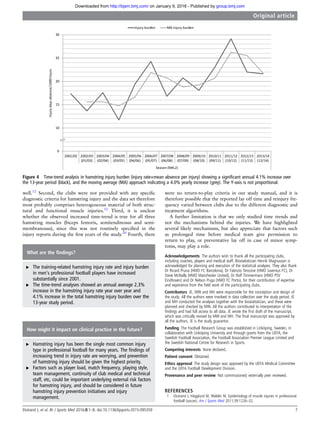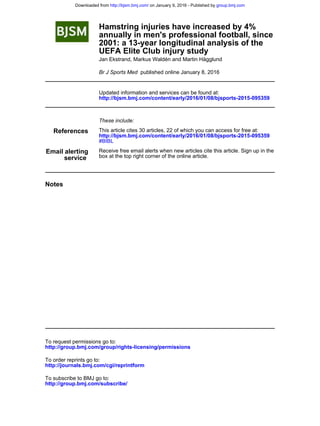From 2001 to 2014, hamstring injuries in men's professional football increased annually by 4%, with a recorded total of 1,614 injuries across 36 clubs. The study found match injury rates to be nine times higher than training rates, although the latter showed a substantial increase over time, implicating challenges in reducing them without affecting performance. Overall, the data highlight a concerning trend of rising hamstring injury rates during training, while match-related injury rates remained stable.
![Hamstring injuries have increased by 4% annually in
men’s professional football, since 2001: a 13-year
longitudinal analysis of the UEFA Elite Club injury
study
Jan Ekstrand,1,2,3
Markus Waldén,1,2
Martin Hägglund2,4
1
Division of Community
Medicine, Department of
Medical and Health Sciences,
Linköping University,
Linköping, Sweden
2
Football Research Group,
Linköping, Sweden
3
UEFA Medical Committee,
Nyon, Switzerland
4
Division of Physiotherapy,
Department of Medical and
Health Sciences, Linköping
University, Linköping, Sweden
Correspondence to
Professor Jan Ekstrand, Division
of Community Medicine,
Department of Medical and
Health Sciences, Linköping
University, Hertig Karlsgatan
13B, Linköping S-582 21,
Sweden;
jan.ekstrand@telia.com
Accepted 11 December 2015
To cite: Ekstrand J,
Waldén M, Hägglund M. Br
J Sports Med Published
Online First: [please include
Day Month Year]
doi:10.1136/bjsports-2015-
095359
ABSTRACT
Background There are limited data on hamstring
injury rates over time in football.
Aim To analyse time trends in hamstring injury rates in
male professional footballers over 13 consecutive
seasons and to distinguish the relative contribution of
training and match injuries.
Methods 36 clubs from 12 European countries were
followed between 2001 and 2014. Team medical staff
recorded individual player exposure and time-loss
injuries. Injuries per 1000 h were compared as a rate
ratio (RR) with 95% CI. Injury burden was the number
of lay off days per 1000 h. Seasonal trend for injury was
analysed using linear regression.
Results A total of 1614 hamstring injuries were
recorded; 22% of players sustained at least one
hamstring injury during a season. The overall hamstring
injury rate over the 13-year period was 1.20 injuries per
1000 h; the match injury rate (4.77) being 9 times
higher than the training injury rate (0.51; RR 9.4; 95%
CI 8.5 to 10.4). The time-trend analysis showed an
annual average 2.3% year on year increase in the total
hamstring injury rate over the 13-year period (R2
=0.431,
b=0.023, 95% CI 0.006 to 0.041, p=0.015). This
increase over time was most pronounced for training
injuries—these increased by 4.0% per year (R2
=0.450,
b=0.040, 95% CI 0.011 to 0.070, p=0.012). The
average hamstring injury burden was 19.7 days per
1000 h (annual average increase 4.1%) (R2
=0.437,
b=0.041, 95% CI 0.010 to 0.072, p=0.014).
Conclusions Training-related hamstring injury rates
have increased substantially since 2001 but match-
related injury rates have remained stable. The challenge
is for clubs to reduce training-related hamstring injury
rates without impairing match performance.
INTRODUCTION
Muscle injuries are a substantial problem for pro-
fessional football players. They constitute more
than one-third of all time-loss injuries and cause
more than a quarter of the total injury absence in
high-level European professional football clubs.1
Hamstring injury is the most common injury
subtype, representing 12% of all injuries, and a
team with a 25 player-squad typically suffers about
5–6 hamstring injuries each season, equivalent to
more than 80 days involving football activities
(training or matches) lost due to injury.1
The overall burden of muscle injuries could be
very significant for professional football clubs.2 3
The average cost of a first-team player in a
professional team being injured for 1 month is cal-
culated to be around €500 000.4
Eccentric muscle
strength training has been promoted as a method
to prevent hamstring injuries.5–10
In a randomised
controlled trial (RCT), eccentric training with the
‘Nordic hamstring (NH) exercise’ significantly
decreased the rate of hamstring injuries in Danish
elite, subelite and amateur players,8
and in Dutch
amateur players.9
However, adoption and imple-
mentation of the NH exercise programme in men’s
professional football in Europe is low, too low to
expect any overall effect on hamstring injury rates
from.11
In male professional football players, the muscle
injury rate has remained high and unchanged for
more than a decade.12
It is, however, unclear from
that study whether this is also true for the main
subgroups of muscle injuries. To the best of our
knowledge, the development of hamstring injuries
over time in football has not been investigated
before. The objective of this study was therefore to
describe the time trend in hamstring injury rate in
men’s professional football in Europe over 13 con-
secutive seasons, and to distinguish the relative con-
tribution of training and match injuries.
Our hypothesis was that the hamstring injury
rate, similar to the overall muscle injury rate,
would remain constant.
MATERIAL AND METHODS
This is a substudy of a long-term prospective
cohort study evaluating male professional football
in Europe funded by the UEFA. A total of 36 clubs
from 12 countries were followed over a varying
number of seasons from 2001 to 2014, with a total
of 209 club-seasons included. The study design
adhered to the consensus statement on injury defi-
nitions and data collection procedures in football,13
and the general methodology has been reported
elsewhere.14
Inclusion criteria and definitions
All players belonging to the first-team squads each
season were eligible for inclusion. Players who were
transferred to other clubs or who finished their
contracts due to other reasons before the end of a
season were included for as long as they played for
the club. Only players who were contracted to the
club for at least half the season (≥5 months) were
included in this substudy, since having many players
with exposure for only a month or two would
skew the prevalence figures as well as the exposure
Ekstrand J, et al. Br J Sports Med 2016;0:1–8. doi:10.1136/bjsports-2015-095359 1
Original article
BJSM Online First, published on January 8, 2016 as 10.1136/bjsports-2015-095359
Copyright Article author (or their employer) 2016. Produced by BMJ Publishing Group Ltd under licence.
group.bmj.comon January 9, 2016 - Published byhttp://bjsm.bmj.com/Downloaded from](https://image.slidesharecdn.com/hamstringinjurieshaveincreasedby4annually-160711130441/85/Hamstring-injuries-have-increased-by-4-annually-1-320.jpg)
